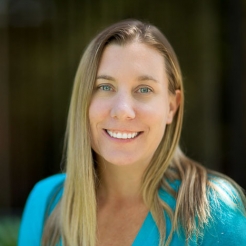Robin Dodson, ScD

Dr. Robin Dodson is Associate Director of Research Operations and a research scientist with expertise in exposure assessment, particularly in the indoor environment. Her research focuses on three main areas: development of novel exposure measurements for epidemiological and community-based studies, analysis of environmental exposure data with a particular emphasis on semi-volatile organic compounds such as phthalates and flame retardant chemicals, and intervention studies aimed at reducing chemical exposures. Dr. Dodson oversees the Institute’s consumer product exposure research. She was the lead author on a landmark peer-reviewed study on endocrine disrupting and asthma-associated chemicals in more than 200 consumer products. As part of the Centers for Disease Control’s Green Housing study, she is currently investigating exposure in children with asthma to chemicals in consumer products and building materials. She leads Silent Spring’s Healthy Green Campus project, a research effort aimed at making health an integral part of sustainability practices on college campuses.
Dr. Dodson completed her doctorate in environmental health at the Harvard T.H. Chan School of Public Health. For her graduate work, she designed and conducted an exposure study in the Boston area focusing on residential and personal exposures to volatile organic compounds. She developed models to evaluate the transport of pollutants in the indoor environment and determine the contribution of various microenvironments to personal exposures. In addition, she evaluated methods for using existing residential exposure data to model residential exposures in the general population. As a graduate student, she contributed to two studies focusing on asthma in lower-socioeconomic-status urban residences in the Boston area.
Dr. Dodson is an adjunct assistant professor of environmental health at Boston University School of Public Health and also holds an appointment as a visiting scientist at Harvard T.H. Chan School of Public Health. She previously taught biostatistics at Brandeis University for eight years. Prior to her graduate work, Dr. Dodson worked at Menzie-Cura and Associates, where she contributed to both human and ecological risk assessments. In addition to her doctorate, Dr. Dodson holds a bachelor’s in environmental studies from Bates College, where she was inducted into the Phi Beta Kappa Academic Honor Society, and a master’s in environmental science and risk management from the Harvard T.H. Chan School of Public Health.
Dr. Dodson’s interest in studying air pollution began in sixth grade when she first learned about the depleting effects of chlorofluorocarbons on the ozone layer. Today, she has dedicated her career to improving public health through her applied research, and hopes to inspire a new generation of young girls to become “future scientists.”
Projects
Publications & Presentations
Zota, A.R., E.T. Franklin, E.B. Weaver, B. Shamasunder, A. Williams, E.L. Siegel, R.E. Dodson. 2023. Examining differences in menstrual and intimate care product use by race/ethnicity and education among menstruating individuals. Frontiers in Reproductive Health. https://doi.org/10.3389/frph.2023.1286920
Knox, K.E., R.E. Dodson, R.A. Rudel, C. Polsky, and M.R. Schwarzman. 2023. Identifying toxic consumer products: Novel data set reveals air emissions of potent carcinogens, reproductive toxicants, and developmental toxicants. Environmental Science & Technology. https://doi.org/10.1021/acs.est.2c07247
Dodson, R.E., K.E. Manz, S.R. Burks, R. Gairola, N.F. Lee, Y. Liu, K.D. Pennell, E.D. Walker, and J.M. Braun. 2022. Does Using Corsi–Rosenthal Boxes to Mitigate COVID-19 Transmission Also Reduce Indoor Air Concentrations of PFAS and Phthalates. Environmental Science & Technology. https://doi.org/10.1021/acs.est.2c05169
Martin, L., Y. Zhang, O. First, V. Mustieles, R. Dodson, G. Rosa, A. Coburn-Sanderson, C.D. Adams, C. Messerlian. 2022. Lifestyle interventions to reduce endocrine-disrupting phthalate and phenol exposures among reproductive age men and women: A review and future steps. Environment International. https://doi.org/10.1016/j.envint.2022.107576
Schildroth, S., K.M. Rodgers, M. Strynar, J. McCord, G. Poma, A. Covaci, R.E. Dodson. 2022. Per-and polyfluoroalkyl substances (PFAS) and persistent chemical mixtures in dust from U.S. colleges. Environmental Research.
206. https://doi.org/10.1016/j.envres.2021.112530.Dodson, R.E., R.W. Setzer, J.D. Spengler, J.G. Brody, R. A. Rudel &. J.G. Cedeño Laurent. 2021. Influence of living in the same home on biomonitored levels of consumer product chemicals. Journal of Exposure Science & Environmental Epidemiology. doi.org/10.1038/s41370-021-00368-8
Dodson R.E., B. Cardona, A.R. Zota, J.R. Flint, S. Navarro, B. Shamasunder. 2021. Personal care product use among diverse women in California: Taking Stock Study. Journal of Exposure Science & Environmental Epidemiology. doi.org/10.1038/s41370-021-00327-3
Rodgers, K.M., D. Bennett, R. Moran, K. Knox, T. Stoiber, R. Gill, T.M. Young, A. Blum, R.E. Dodson. 2021. Do flame retardant concentrations change in dust after older upholstered furniture is replaced? Environment International. doi.org/10.1016/j.envint.2021.106513
Dodson, R.E., K. E. Boronow, H. Susmann, J.O. Udesky, K.M. Rodgers, D. Weller, M. Woudneh, J.G. Brody, R.A. Rudel. 2020. Consumer behavior and exposure to parabens, bisphenols, triclosan, dichlorophenols, and benzophenone-3: Results from a crowdsourced biomonitoring study. International Journal of Hygiene and Environmental Health. doi.org/10.1016/j.ijheh.2020.113624
Rodgers, K.M., A. Covaci, G. Poma, K. Knox, J.G. Allen, J. Cedeno-Laurent, R.A. Rudel, R.E. Dodson. 2020. Flame retardant concentrations are lower in college spaces meeting the new furniture flammability standard TB117-2013. Environmental Science & Technology Letters. doi.org/10.1021/acs.estlett.0c00483
Udesky, J.O., R.E. Dodson, L.J. Perovich, R.A. Rudel. 2019. Wrangling environmental exposure data: guidance for getting the best information from your laboratory measurements. Environmental Health. 18: 99. doi.org/10.1186/s12940-019-0537-8
Goodwin Robbins, L.J., K.M. Rodgers, B. Walsh, R. Ain, R.E. Dodson. 2019. Pruning chemicals from the green building landscape. Journal of Exposure Science & Environmental Epidemiology. doi.org/10.1038/s41370-019-0174-x
Rodgers, K.M., L.R. Swetschinski, R.E. Dodson, H.R. Alpert, J.M. Fleming, and R.A. Rudel. 2019. Health Toll from Open Flame and Cigarette-Started Fires on Flame-Retardant Furniture in Massachusetts, 2003–2016. American Journal of Public Health. DOI:10.2105/AJPH.2019.305157
Dembsey, N.A., F.M. Brokaw, H.M. Stapleton, R.E. Dodson, J. Onasch, E. Jazan, C.C. Carignan. 2019. Intervention to Reduce Gymnast Exposure to Flame Retardants from Pit Foam: A Case Study. Environment International. DOI: 10.1016/j.envint.2019.01.084
Helm, J.S., M.N. Nishioka, J.G. Brody, R.A. Rudel, R.E. Dodson. 2018. Measurements of Endocrine Disrupting and Asthma-Associated Chemicals in Hair Products Used by Black Women. Environmental Research. doi:10.1016/j.envres.2018.03.030.
Dodson, R.E., J.O. Udesky, M.D. Colton, M. McCauley, D.E. Camann, A.Y. Yau, G. Adamkiewicz, R.A. Rudel. 2017. Chemical exposures in recently renovated low-income housing: Influence of building materials and occupant activities. Environment International. 109:114-127. doi.org/10.1016/j.envint.2017.07.007
Dodson, R.E., K.M. Rodgers, G. Carey, J.G. Cedeno Laurent, A. Covaci, G. Poma, G. Malarvannan, J.D. Spengler, R.A. Rudel, J.G. Allen. 2017. Flame Retardant Chemicals in College Dormitories: Flammability Standards Influence Dust Concentrations. Environmental Science & Technology, 51(9):4860–4869. doi:10.1021/acs.est.7b00429
Mitro, S.D., R.E. Dodson, V. Singla, G. Adamkiewicz, A.F. Elmi, M.K. Tilly, A.R. Zota. 2016. Consumer product chemicals in indoor dust: a quantitative meta-analysis of U.S. studies. Environmental Science & Technology, 50(19):10661–10672. doi:10.1021/acs.est.6b02023
Dodson, R.E., L.J. Perovich, A. Covaci, N. Van den Eede, A.C. Ionas, A.C. Dirtu, J.G. Brody, R.A. Rudel. 2012. After the PBDE phase-out: A broad suite of flame retardants in repeat house dust samples from California. Environmental Science & Technology, 46(24):13056–13066. doi:10.1021/es303879n
Dodson, R.E., M. Nishioka, L.J. Standley, L.J. Perovich, J.G. Brody, R.A. Rudel. 2012. Endocrine Disruptors and Asthma-Associated Chemicals in Consumer Products. Environmental Health Perspectives, 120(7):935–943. doi:10.1289/ehp.1104052




